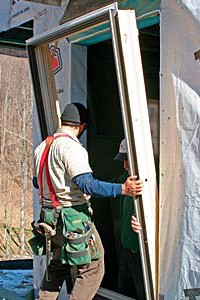Great care must be taken when selecting and installing window wall systems in your home. If the product or installation is faulty, you could run into problems like water and air infiltration, mold, condensation, and structural damage. And no one wants to deal with that.
Let’s take a look at how you can avoid these problems.
In this article, you’ll learn 4 things to know about selecting and installing window walls in your home:
- How windows are built.
- How window walls are installed.
- Pros and cons of different types of window wall installers.
- The importance of proper window wall installation.
This post is part of a larger series of articles on residential window walls. If you’d like to learn more, check out our first post in the series: What you need to know about window walls before you start designing where you’ll find links to all the posts we’ve published in this series.
1. How Are Window Walls Built?
In general, there are 2 ways window walls are built: in the factory and on site.

This installation type is typically more expensive and leaves the most room for error if the installation is poorly handled, but can result in some of the nicest window systems around. As long as you have a quality product and a reputable installer, site-built window walls can create excellent windows for your home. Just do you due diligence and research the reputation of installers first.

In general, a majority of windows are factory-built. But, because larger window wall designs are becoming more and more popular, window manufacturers are fabricating them so that individual windows can be secured or mulled together. Mulling them together in the shop can save time and money. But if the layout is too large to build in the shop and transport safely to the job site, manufacturers will mull some units together, then leave the remaining units to be secured together in-place on the job site.
2. How Are Window Walls Installed?
Window wall systems are installed in one of two ways: with concealed anchors, clips, and fasteners or with nailing flanges.
Window walls with anchors and clips are typically fastened to the sides, top, and bottom of the wall framing where they secure to wall studs, blocking, and headers.



Windows with nailing flanges are secured to the wall through the face of the sheathing on the exterior.
The main difference between these two installations is how the flashing and water-resistive barrier are installed. When you have anchors and clips, your flashing and water-resistive barrier returns into the window opening. The small gap around the windows is then closed up with sealant and backer rods. With a nailing flange, the flashing is installed over of the nailing fin in a shingled fashion to shed water away from the window opening. There’s a small variation between the two installation types but either installation can lead to major problems if not installed properly.
What Type of Window Wall Installation is Best?
Your window wall installation will depend on a few factors:
- How complicated your window wall design is.
- The window wall company you select.
- The experience level of your general contractor.
- Your level of comfort, preference, and budget.
Neither installation is better or worse than the other as long as they’re installed properly. Some experts prefer nailing flanges since they the flange actually covers over the gap between the wall and the window frame. However, for many larger window walls, nailing flanges are not an option. As long as either installation is done properly, both can provide fully waterproof systems.
And the best way to ensure your installation is done properly is to use qualified installers and professionals who have experience in window wall installation.
Depending on the window wall product you select, some companies have their own trained installers, some recommend specific reputable installers, and some require you to find your own installer.
3. Pros and Cons of Different Types of Window Wall Installer
1. Window wall company installs their own systems: This is probably the safest bet among all installation options for simple and complex window wall designs. Company installers have spent hours learning how to properly install their windows, understanding where problems may arise, catching them in advance, and fixing them. This installation typically will also come with a warranty from the window wall company on their own installation. They’ve also spent many hours installing their own windows on various projects so their reputation and success are public knowledge. Homeowners are NOT afraid to vocalize their dissatisfaction. So check online for personal accounts and opinions of specific company installers before selecting your windows.
2. Separate window wall installers: Some window wall companies don’t install their own windows. For complex window wall types, companies often recommend window installers that have experience and success installing their specific systems. The advantage of this type of installer is that they are usually very good at installing their windows. Since this is their bread and butter business (installing other company’s windows) they had better be the best or their business wouldn’t exist. They also usually sometimes will warranty their installation.
The disadvantage of this type of installer is that they are typically more expensive. With their expertise in specialized and complicated window systems, they tend to monopolize the industry and have higher rates. They also often have a long backlog of work resulting in longer waits. If you have a simpler window layout, this specialized installer may not be necessary.
3. General contractor installed: For smaller window openings and for certain window products that are individual window units instead of multiple window units mulled together, a general contractor can usually install these. These windows traditionally are inserted into individual rough openings of wall framing not large wall openings. In most cases, these individual window units come with nailing fins that make installation easier. An installer simply shims the window plumb and then nails the window to the wall sheathing through the nailing fins.
For more complicated window wall systems with numerous windows mulled together and large spans, the best choice for installers may not be a general contractor. Some window wall systems are very complicated with a lot of parts, clips, fasteners, and anchoring methods, and attachments that might be too much for a GC. These larger systems have parts that must be installed in a certain sequence to fit together and function properly. Would you want to trust this complicated installation process to a GC?
4. The Importance of Proper Window Wall Installation
It can’t be stressed enough the importance of proper window wall installation. Proper installation ensures your windows and doors won’t leak and that your conditioned air (heated or cooled) won’t escape.
Very important to the success of the entire wall assembly is the integration of the water resistive barrier and the window/door flashing. The role of flashing is to direct water away from your window opening and onto the water resistive barrier, which in turn directs water out of your wall.
Improper window wall flashing and sealing leads to water and air infiltration, mold, and damages to your interior finishes. Nobody wants that.
A good window wall installation begins before the windows are even installed. Depending on your window wall system, whether it has anchors and clips or nailing fins you, you’ll have to think about the sequence of how your windows, flashing, and water and air barriers will get installed. There is a precise order to how and when each component is installed and any deviation from that sequence puts your wall at greater risk of failing.
This is one of the most important construction sequences to get correct. We’ve seen contractors who fail to install the flashing properly and fail to lap the water-resisitve barrier in a shingled manner (to ensure proper water drainage). In both cases, had we not noticed or said anything, construction would have continued, concealing the faulty work, and most likely would have caused leaks.
Follow along in our Window Wall Design Series. We’ve explored inspiring projects, the benefits of window walls, various types of window walls and glazing. We’ve also discussed durability, quality and high-performance standards.
[Featured image of the Summer House Gravråk by Carl-Viggo Hølmebakk. Photo courtesy Carl-Viggo Hølmebakk.]





![5 [BIG] Design Moves](https://i0.wp.com/yr-architecture.com/wp-content/uploads/5-BIG-Design-Moves.jpg?fit=800%2C533&ssl=1)









